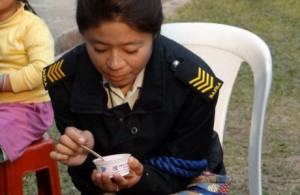From biogas to ice cream, Bhutan’s newest ‘cool thing’

The Bhutanese village of Singyegang, with 450 inhabitants, is home to hot and humid summers. It’s the kind of weather that calls for refreshments — and ice cream tops the list. Until now, it was a “foreign” treat, mainly imported from neighboring India.
But one small group of farmers saw an opportunity and took a risk, turning a biogas project, supported by the United Nations Development programme (UNDP) and the Ministry of Agriculture and Forests, into something “cooler”: Bhutan’s very first ice cream factory.
Simply named Bhutan Ice Cream, the farmers’ move surprised the villagers, who never considered the possibility of producing ice cream at a national level.
Gauri Shanker, the farmers’ group chairperson, is very happy with the results.
“Before, a liter of milk would fetch us Nu. 30 (or US $0.50),” he says. “Now, with the same liter of milk, if you make ice cream, you earn about Nu. 400 ($6.67).”
The factory is not just a commercial success; it is also a culinary innovation in the country.
“We used to fill a small plastic bowl with milk and put it inside a freezer. Now we can make ice cream with the machine,” Shanker added.
The treat is available in both cones and cups, with original labels and packaging. The brand has five different flavors: vanilla, butterscotch, Kesar Pista, strawberry and mixed-fruit.
Besides ice cream, the factory also produces cottage cheese, yogurt and butter. The farmers’ revenue has risen 600 percent from when they only sold milk.
“The innovative idea was born from the climate change mitigation project focused on piloting biogas in Bhutan,” said Singay Dorji, UNDP’s GEF-Small Grants Programme National Coordinator. “The group is an exemplary model in reducing fuel wood consumption, promoting entrepreneurship and generating sustainable income for communities.”
The manufacturing unit has the potential to produce 4,500 packets of ice cream per day. For now, the ice cream is only available in Singyegang, but the farmers are planning to purchase more cattle and expand the business to help create more employment. Right now, 25 households are contributing milk daily.
The GEF-Small Grants Programme was launched in Bhutan in October 1998. Under the current operation phase (2011 to 2014), this partnership with UNDP currently supporting 58 projects in biodiversity conservation, climate change and land degradation, spread over 19 of the country’s 20 districts.
